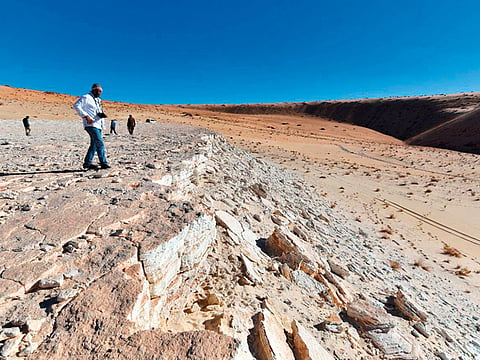85,000-year-old footprints found in kingdom
Fossil shows region comprising present-day Saudi Arabia was at crossroads of Great Migration route

Manama: In a breakthrough that indicated the ancient people probably left Africa through Sinai, 85,000-year-old human footprints have been discovered in Saudi Arabia’s north-western Tabuk region.
The footprints of many adult humans carved deep in rocks were discovered on the banks of an ancient lake bed in the Nafud desert that scientists say was once a lush and damp area teeming with life, Prince Sultan Bin Salman, President of the Saudi Commission for Tourism and National Heritage (SCTH), said during a visit to the National Museum of Tokyo. He was hosting the “Roads of Arabia — Saudi Archaeological Masterpieces through the Ages” exhibition.
The footprints lead away from the lake in different directions. Researchers say the discovery showed that hunter-gatherers had come to the area at that time, and that they might also have fished in the lake.
“This is a wonderful and very rare discovery that shows man’s arrival in the Arabian Peninsula from Africa alongside other human migrations,” Prince Sultan was quoted by the Riyadh-based Centre for International Communication (CIC) as saying.
“These important discoveries highlight the historical status of the Saudi Arabia and its cultural depth, and it being the cradle of the beginnings of human civilisations.”
The discovery was made by a team of researchers from the Saudi Geological Survey, SCTH, King Saud University, Max Planck Foundation for Human History, Oxford University, Cambridge University, Australia National and the University of New South Wales in Australia.
Prince Sultan said the footprints dated back to the same period as the fossil of an adult human finger, found in 2016 in Tabuk region’s Tayma province, about 150 kilometres north-west of Al Ula.
The site contains evidence of major civilisations dating back more than 4,000 years, including the Lihyan and the Nabataean kingdoms.
The fossil, believed to be the oldest evidence of Homo Sapiens found outside Africa and the Levant, was presented by Michael Petraglia of the Department of Human Evolution at the Max Planck Institute.
The discovery points to a new understanding of how humans came out of Africa and moved to different parts of the world. Petraglia said the discovery indicated the ancient people probably left Africa through Sinai.
These discoveries were made possible thanks to a the “Green Arabia” programme in which SCTH is collaborating with Oxford University to trace historical climate changes on the Arabian Peninsula. The project found evidence of hundreds of rivers, lakes and forests that used to cover the land that is now a desert.
The project has also led to discoveries of animal and mammal fossils in the Saudi desert, including a 300,000-year-old mammoth tusk in Nafud. An elephant’s carpal bone, located five metres from the tusk, was also discovered in the same sand layer at the excavation site.
Sign up for the Daily Briefing
Get the latest news and updates straight to your inbox



